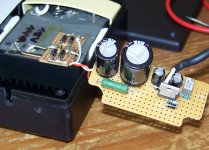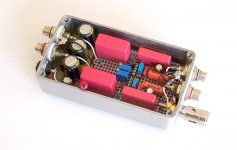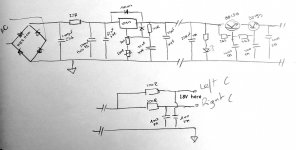Thanks, i am learning a lot. I guessed that you put some other factors inside your RIAA Calculation.
How big is the impact of changing source or drain resistors on Q1 and Q2? Is it like "1%" or more like "10%" alteration of the RIAA curve? (I know its more complex but i need a guess value..)
At which point should i start to recalculate the values of the RIAA filter?
Can't quantify it, depends on each circuit, its a very general question. Better post your current iteration's schematic and I will simulate it when having some time so we see how close the modeling gets to what you verified. Then we can tweak things and see how it changes.
okay, i hear the calling to go and get me a reverse-RIAA module. Would a Hagtech style design do the job well enough?
I measured again with my fg and oscilloscope, using the following method:
mh-audio.nl - Home
I noticed a loss of low bass compared to my previous version. I have -2.254 db loss at 20 Hz. At 40 Hz = -0.9 db, at 50 Hz = -0.665 dB, at 60 Hz = -0.19 dB, at 80 Hz -0.18 dB.
maybe my first coupling cap is too small? Or is it about the corner frequencies of the Riaa curve?
Frequencies from 100 Hz to 8 kHz are all boosted by +0.2 dB to +0.4 dB.
At 15 kHz it measures +0.8 dB and at 20 kHz its +0.7dB.
I will draw a new circuit scheme with my actual values to complete documentation. Thanks for your offer to simulate it sometimes to compare simulation and measuring.
I fear that my measuring tolerances are up to 1dB or more, so it is more about seeing a trend then measuring it exactly. But what we can see is that 20Hz has a loss of almost 3dB while 20 kHz is boosted by 0.7dB (i want to keep the boost at 20 kHz because of my dull sounding mm carts ;-).
I measured again with my fg and oscilloscope, using the following method:
mh-audio.nl - Home
I noticed a loss of low bass compared to my previous version. I have -2.254 db loss at 20 Hz. At 40 Hz = -0.9 db, at 50 Hz = -0.665 dB, at 60 Hz = -0.19 dB, at 80 Hz -0.18 dB.
maybe my first coupling cap is too small? Or is it about the corner frequencies of the Riaa curve?
Frequencies from 100 Hz to 8 kHz are all boosted by +0.2 dB to +0.4 dB.
At 15 kHz it measures +0.8 dB and at 20 kHz its +0.7dB.
I will draw a new circuit scheme with my actual values to complete documentation. Thanks for your offer to simulate it sometimes to compare simulation and measuring.
I fear that my measuring tolerances are up to 1dB or more, so it is more about seeing a trend then measuring it exactly. But what we can see is that 20Hz has a loss of almost 3dB while 20 kHz is boosted by 0.7dB (i want to keep the boost at 20 kHz because of my dull sounding mm carts ;-).
The multiplier's BD139s will not need sinks in your application I might add. Its output capacitor might be even smaller but don't change the 2k2 and 1000uF parts or the transistors type. Easy to make. Let us know your results.
Done, LM317 adjusted for 18V (after the 100R added before each channel for filtering/separation), 9V at Q2's drain. So far no smoke. It's a funny slow charging supply (about a minute), and I guess the output DC drift is caused by this. My DMM shows nothing obvious at outputs (what can be real levels of faint hum or such? Well below the DMM abilities?), next step is to put it back in service. And that's the scary part...
Attachments
Hi fellows,
It's up and running. I feel it's a touch cleaner and has more and better bass. Great bass that no cheap CD player/DAC can do. I admint my former supply was a recycled one, not a dedicated one like now, enough for a real gain or it's all in my head?
ST200, if was for my case, as other needed help and also chimed in, it's very balanced and good sounding.
Thanks Salas, cheap and good sounding pre-phono for now!
It's up and running. I feel it's a touch cleaner and has more and better bass. Great bass that no cheap CD player/DAC can do. I admint my former supply was a recycled one, not a dedicated one like now, enough for a real gain or it's all in my head?
ST200, if was for my case, as other needed help and also chimed in, it's very balanced and good sounding.
Thanks Salas, cheap and good sounding pre-phono for now!
Its a real gain I believe. Sounds more like a battery supply now from the way you describe. I can see three same capacitors in the multiplier (probably 1000uF) but can you sketch what more you added and how you connected it, as you mentioned 100R resistors, and I also see one smaller capacitor there?
Pen is faster before you will learn any new to you software, but maybe something like this?
Free Circuit Drawing Software: SchemeIt - Build Electronic Circuits
Free Circuit Drawing Software: SchemeIt - Build Electronic Circuits
Comprehensive schematic. Thanks. So the 100R 100uF RC filters are positioned after the 1000uF multiplier's output capacitor? If yes bypass those resistors and listen again. The cells with smaller caps do improve split theoretically but alter the output impedance of the multiplier also. Given your layout characteristics and the specific phono maybe they help or not.
Yes the "18V here" is where I measured for the LM317 adjustement, the supply being applied before that small RC.
I'll keep that test in mind, it's a tight fit in its box and in my hifi rack, I allow myself to enuoy some new records and will try a bit later
You're a perfectionist, nice for us Thank you!
Thank you!
I'll keep that test in mind, it's a tight fit in its box and in my hifi rack, I allow myself to enuoy some new records and will try a bit later
You're a perfectionist, nice for us
Last edited:
Too technical for me 
Anyway, I have a question about that last modification. And it can be answered by yes/no. Is there a possibility the sound gets better, not just different? You've seen guys how I had to fight to get my LP playback rig to sound right, and it does now.
So I am ready to remove the 100R if the worst case is no change and best case better sound. If there is a chance I mess the sound well I may wait later or go for a real big gun phono...
To make it short: can't make things go bad, can it?
Anyway, I have a question about that last modification. And it can be answered by yes/no. Is there a possibility the sound gets better, not just different? You've seen guys how I had to fight to get my LP playback rig to sound right, and it does now.
So I am ready to remove the 100R if the worst case is no change and best case better sound. If there is a chance I mess the sound well I may wait later or go for a real big gun phono...
To make it short: can't make things go bad, can it?
Oh I see, one angel and one devil on my shoulders... 
Being here and only human I've chosen the trouble!
I'll try to share what I feel. It's not worst for sure, maybe, psycho and such, maybe it leans towards more life and cleaner instruments, Robert Bowie's trumpet and fellow vibraphone seams more dynamic, cleaner. The 'oh my that bass' is no more drawing attention but a 'that is serious crazy trumpet'. Maybe I just get used to it but even if it's in my head I like it at least as much, maybe more, what I hear, and my Velleman soldering station passed away.
Damn costy tools...
Again, thanks for support
Edit: listening to Moodoïd 'La Montagne', I'm positive there is an improvement in overall clarity.
Being here and only human I've chosen the trouble!
I'll try to share what I feel. It's not worst for sure, maybe, psycho and such, maybe it leans towards more life and cleaner instruments, Robert Bowie's trumpet and fellow vibraphone seams more dynamic, cleaner. The 'oh my that bass' is no more drawing attention but a 'that is serious crazy trumpet'. Maybe I just get used to it but even if it's in my head I like it at least as much, maybe more, what I hear, and my Velleman soldering station passed away.
Damn costy tools...
Again, thanks for support
Edit: listening to Moodoïd 'La Montagne', I'm positive there is an improvement in overall clarity.
Last edited:
- Status
- This old topic is closed. If you want to reopen this topic, contact a moderator using the "Report Post" button.
- Home
- Source & Line
- Analogue Source
- Pacific RIAA phono pre: failure!




